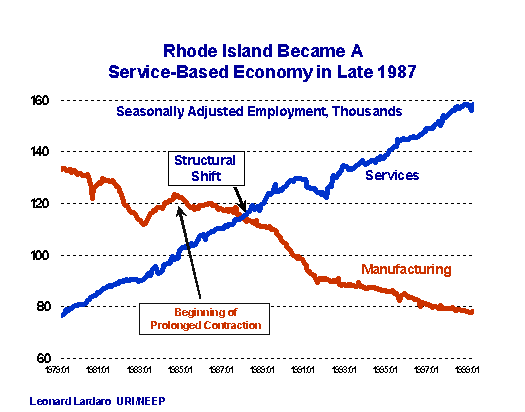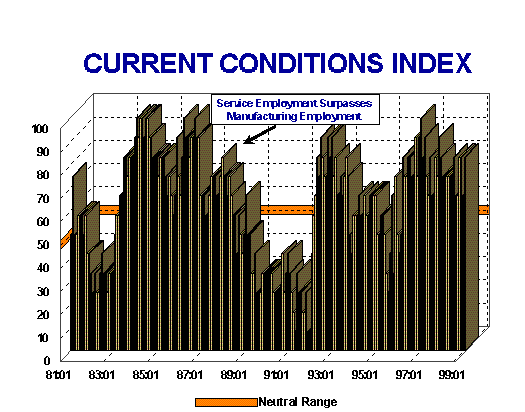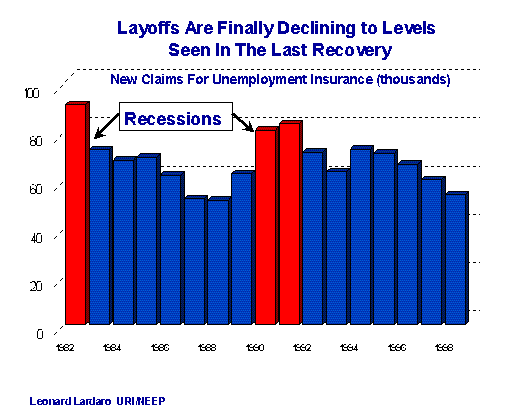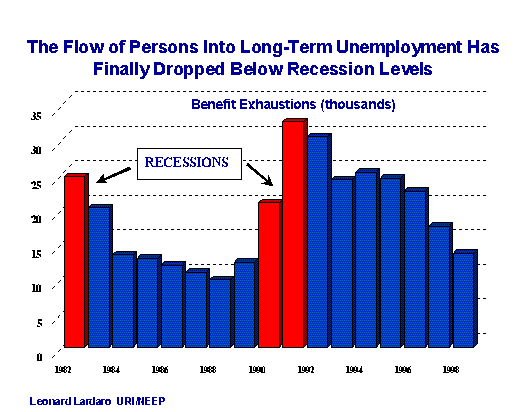

|
When Rhode Island's Structural Shift Occurred |
|
 |
In 1987, manufacturing employment for Rhode Island was surpassed by (Miscellaneous) Service employment, marking its transition from a manufacturing-based economy to one driven by information and services. Ever since this major structural change, a series of negative structural factors have combined with the usual business cycle (i.e., cyclical) forces to alter economic activity in Rhode Island, at times making this appear to be a very slow recovery. It should be obvious from this graph, that annual job growth from manufacturing in the aggregate last took place in 1984. As of the beginning of 1999, Service employment, a major source of job growth for Rhode Island, is almost twice the level of manufacturing employment.
|
|
The Slowdown in the 1980s Began Well Before the 1989 Recession |
|
 |
The Current Conditions Index, which reflects the overall state of the Rhode Island economy at any point in time, shows the effects of the structural shift to a service and information based economy. Note that the CCI began a prolonged decline well before the recession that began in June, 1989. In fact, this decline began in 1987, at almost the same time that manufacturing employment fell below service employment. Then the structural "negatives" began to offset the remaining cyclical "positives," so that the Rhode Island economy began growing more slowly well before the recession hit. Add to this the major defense cutbacks in 1989 and sprinkle all of this with a banking crisis in 1991, and the CCI fell as low as 8 (out of 100) on several occasions in 1991. For all of 1991, the CCI averaged 17, a value well below its "neutral" value of 50. A recovery began in 1992 (the CCI rose above 50)that continues to this day. The effects of structural change continue to offset the cyclical gains we experience. To most people, this has meant a weak recovery. In fact, the cyclical activity, which continues to be offset by structural "negatives," is stronger than most Rhode Islanders realized until only recently. |
|
The Persistence of Layoffs |
|
 |
The most visible result of recent structural changes has been the persistence of layoffs, even during the present recovery. The most reliable indicator of layoffs we have is New Claims for Unemployment Insurance (note: this is a component of the CCI). Layoffs have resulted from the incorporation of labor-saving technology into production, and corporate downsizings, including the shift from "vertical" to "horizontal" management. Of course, defense-related layoffs plagued Rhode Island from 1989 through 1997, along with plant closings related to inter-regional and international competition. Note how high layoffs have remained throughout this entire recovery. Today, when employment numbers are released, it must be kept in mind that the monthly employment change is the difference between jobs created and jobs lost. Thus, job creation exceeds the monthly employment change, and job creation has not been as sluggish as commonly presumed. |
|
Rhode Island's Problem with Long-Term Unemployment |
|
 |
One of the most notable differences of this with past recoveries has been the persistence of long-term unemployment, the result of layoffs, corporate downsizings, and relatively slow growth in the demand for labor. The most accurate way for us to track this is to follow the number of persons exhausting Unemployment Insurance benefits (note: this is a component of the CCI). In 1991, Rhode Island's "year from hell," exhaustions rose sharply. Note how slowly exhaustions fell until 1997, when, for the first time this recovery, they finally dropped below recession levels. THUS, FOR RHODE ISLAND, LONG-TERM UNEMPLOYMENT WAS A VERY PRESSING PROBLEM UNTIL VERY RECENTLY. SOME LONG-TERM UNEMPLOYMENT PERSISTS -- FOR PERSONS WHOSE SKILLS DO NOT MATCH THOSE IN DEMAND BY EXPANDING FIRMS AND INDUSTRIES (labor shortages can coexist with labor surpluses). THE CHALLENGE FOR RHODE ISLAND IS TO PROVIDE SUFFICIENT EDUCATIONAL QUALITY THAT EXPANDING FIRMS AND INDUSTRIES HERE WILL BE ABLE TO SATISFY THEIR MANPOWER NEEDS. RHODE ISLAND'S PROBLEMATIC EDUCATIONAL QUALITY (K-12), BODES BADLY FOR MEETING THIS CHALLENGE. MAJOR PROBLEMS STILL PERSIST WITH RHODE ISLAND'S HUMAN CAPITAL INFRASTRUCTURE WHICH RAISES THE COST OF DOING BUSINESS IN THIS STATE. |
Newspaper Articles Dealing with this Structural Transition
![]() RHODE
ISLAND'S SHIFT FROM MANUFACTURING TO SERVICES CONTINUES
RHODE
ISLAND'S SHIFT FROM MANUFACTURING TO SERVICES CONTINUES
![]() RHODE
ISLAND'S ECONOMY IS MORE COMPLICATED TODAY
RHODE
ISLAND'S ECONOMY IS MORE COMPLICATED TODAY
![]() OUR
ECONOMY: THREE STEPS FORWARD, TWO STEPS BACK
OUR
ECONOMY: THREE STEPS FORWARD, TWO STEPS BACK
![]()